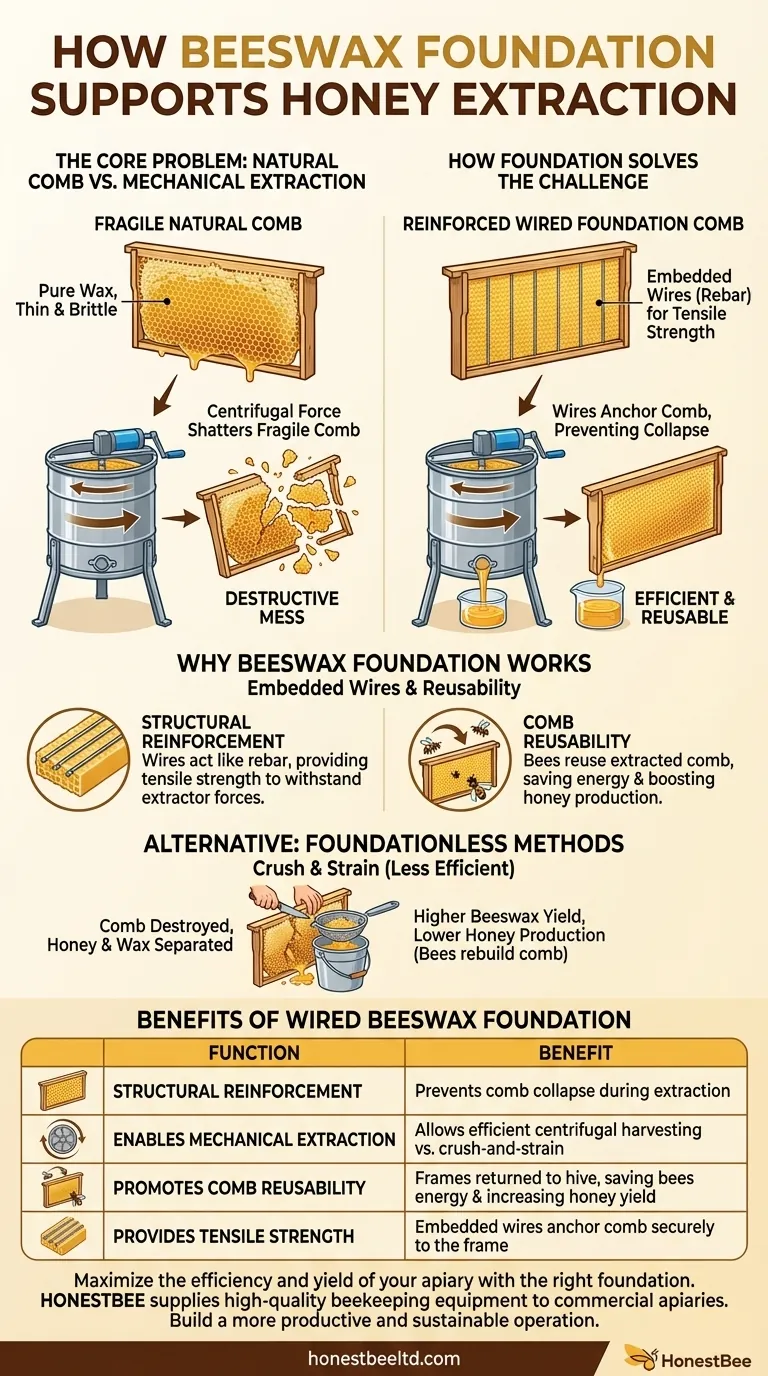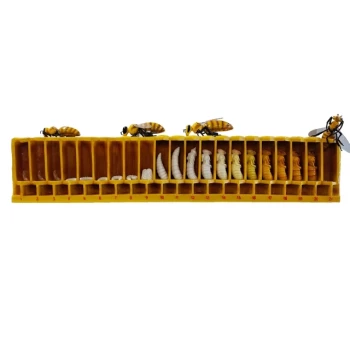Beeswax foundation is essential for modern honey extraction because it provides the structural integrity needed for the process. The foundation, a sheet of beeswax reinforced with embedded wires, acts as a skeleton for the honeycomb, allowing it to withstand the powerful centrifugal forces of a honey extractor without disintegrating under the weight of the honey.
The primary role of beeswax foundation in honey extraction is structural reinforcement. The embedded wires create a durable "skeleton" that prevents the delicate, heavy honeycomb from shattering during the high-speed spinning of an extractor, enabling efficient harvesting and comb reuse.

The Core Problem: Natural Comb vs. Mechanical Extraction
To understand the role of foundation, we must first appreciate the physical challenge of extracting honey. The entire system is designed to overcome the inherent fragility of natural beeswax comb.
The Fragility of Natural Honeycomb
Natural honeycomb is an engineering marvel built by bees, but it is designed only to hang statically within a hive. It is made of pure, thin wax and is extremely brittle, especially when filled with dense, heavy honey.
The Physics of Centrifugal Extraction
A honey extractor is a machine that spins frames at high velocity. This rapid spinning generates immense centrifugal force, which flings the liquid honey out of the wax cells and against the walls of the extractor drum.
The Inevitable Outcome
If you were to place a frame of natural, foundationless comb into an extractor, it would tear itself apart almost instantly. The force would rip the heavy, honey-filled comb from the wooden frame, resulting in a destructive mess of wax, honey, and bee brood.
How Foundation Solves the Structural Challenge
Wired beeswax foundation is the critical innovation that makes mechanical extraction possible. It fundamentally changes the comb from a fragile structure into a durable, reusable resource.
Embedded Wires for Tensile Strength
The thin, crimped wires embedded vertically within the beeswax foundation act like rebar in concrete. They provide the tensile strength the wax lacks.
These wires anchor the entire sheet of comb securely to the wooden frame. When the frame spins, the force is transferred from the wax cells to the wires and, ultimately, to the sturdy frame itself.
Enabling Reusability
Because the comb remains intact after extraction, the frame can be returned to the hive. This is a massive advantage for the bees, who do not have to expend precious energy and resources (nectar) to rebuild the entire comb from scratch.
This reusability directly translates to higher honey yields for the beekeeper, as the bees can immediately begin refilling the empty cells rather than rebuilding them.
Understanding the Trade-offs: Foundation vs. Foundationless
Not all beekeeping methods rely on foundation, but these methods involve a different, and often less efficient, extraction process.
The "Crush and Strain" Method
In foundationless systems, such as top-bar hives or fixed-comb hives, honey is not extracted mechanically. Instead, the beekeeper cuts the entire comb out of the hive.
The comb is then crushed, and the honey is separated from the wax by straining it through a filter. This method destroys the comb completely.
The Yield Difference
While the crush-and-strain method yields a larger beeswax harvest, it significantly reduces potential honey production. The colony must consume a great deal of honey and nectar simply to produce the wax needed to rebuild their comb before they can store surplus honey again.
When to Use Extra Support
For frames intended for long-term use, especially in the brood chamber, beekeepers may add even more reinforcement. Techniques like cross-wiring or using support pins provide extra stability to prevent the comb from sagging over many years of use.
Making the Right Choice for Your Goal
Your approach to using foundation depends entirely on your beekeeping objectives.
- If your primary focus is maximizing honey production and efficiency: Wired beeswax foundation is non-negotiable, as it enables the reuse of drawn comb and efficient mechanical extraction.
- If your primary focus is maximizing beeswax harvest or practicing "natural" beekeeping: A foundationless system using the crush-and-strain method will yield more wax but less honey over time.
Ultimately, foundation transforms honey harvesting from a destructive, one-time event into a sustainable and efficient cycle.
Summary Table:
| Function | Benefit |
|---|---|
| Structural Reinforcement | Prevents comb collapse during high-speed spinning in an extractor. |
| Enables Mechanical Extraction | Allows for efficient, centrifugal honey harvesting vs. destructive crush-and-strain. |
| Promotes Comb Reusability | Frames can be returned to the hive, saving bees energy and boosting honey production. |
| Provides Tensile Strength | Embedded wires act like rebar, anchoring the comb securely to the frame. |
Maximize the efficiency and yield of your apiary with the right foundation. HONESTBEE supplies high-quality beekeeping supplies and equipment—including durable beeswax foundation—to commercial apiaries and beekeeping equipment distributors through our wholesale-focused operations. Let us help you build a more productive and sustainable operation. Contact HONESTBEE today to discuss your needs!
Visual Guide

Related Products
- Notebook Style Beeswax Foundation Mould Wax Foundation Mold
- Electric Beeswax Foundation Machine With Operating Tray and Wax Foundation Roller
- Manual Beeswax Comb Foundation Machine Wax Foundation Mill Embossing Machine
- Electric Flatting and Embossing Machine with Tray for Beekeeping
- Electric Beeswax Flat Sheet Machine with Operating Tray for Wax Processing
People Also Ask
- What are the uses of recycled beeswax cappings? Transform Honey Byproducts into Valuable Assets
- How is beeswax foundation secured in wooden frames? Ensure Strong Comb for Healthy Hives
- How do you use the Foundation Mold to create beeswax foundation? Master DIY Beekeeping with Precision
- Can beeswax foundation be recycled or reused? A Guide to Sustainable Beekeeping
- How is beeswax foundation installed and what are its characteristics? Boost Hive Health Naturally



















